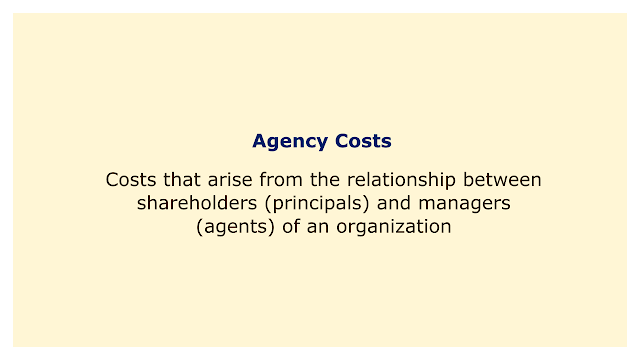 |
| Image: Moneybestpal.com |
Agency costs are expenses that result from the partnership between an organization's shareholders (principals) and managers (agents).
These expenses could be brought on by incentives that aren't aligned, conflicts of interest, or an information gap between the two parties. The costs associated with monitoring, reinforcing, or rewarding managers, as well as losses resulting from ineffective or self-serving managerial choices, are examples of agency costs.
Direct agency costs can be divided into two categories: business expenses that benefit the management team at the expense of the shareholders, and an expense related to managing management decisions to maintain the principal-agent relationship. When the senior management team travels and unnecessarily books the most costly hotel or requests excessive hotel upgrades, for instance, agency fees are incurred. Another illustration is hiring outside auditors to judge the veracity of the business's financial accounts.
Indirect agency costs represent lost opportunities. For instance, the management team might be reluctant to move forward with a project that the shareholders believe will boost the stock's value because they fear it will fail and lead to their dismissal. Shareholders will miss out on a potentially lucrative opportunity if management declines to take on this project.
The agency cost of debt is the increase in debt costs or the application of debt covenants due to concerns about agency cost issues. The management of the corporation, not the debt financiers, is in charge of the funds. The agency cost of debt typically arises when debt holders are concerned that the management team may make hazardous decisions that favor shareholders over bond holders. Debt suppliers may impose limitations on how their money is utilized (such as debt covenants) out of concern about future principal-agent issues in the organization.
In order to lower agency costs, shareholders' and managers' interests should be aligned. This can be done by raising shareholder activism, tying executive compensation to business performance, or enhancing corporate governance.
Direct agency costs can be divided into two categories: business expenses that benefit the management team at the expense of the shareholders, and an expense related to managing management decisions to maintain the principal-agent relationship. When the senior management team travels and unnecessarily books the most costly hotel or requests excessive hotel upgrades, for instance, agency fees are incurred. Another illustration is hiring outside auditors to judge the veracity of the business's financial accounts.
Indirect agency costs represent lost opportunities. For instance, the management team might be reluctant to move forward with a project that the shareholders believe will boost the stock's value because they fear it will fail and lead to their dismissal. Shareholders will miss out on a potentially lucrative opportunity if management declines to take on this project.
The agency cost of debt is the increase in debt costs or the application of debt covenants due to concerns about agency cost issues. The management of the corporation, not the debt financiers, is in charge of the funds. The agency cost of debt typically arises when debt holders are concerned that the management team may make hazardous decisions that favor shareholders over bond holders. Debt suppliers may impose limitations on how their money is utilized (such as debt covenants) out of concern about future principal-agent issues in the organization.
In order to lower agency costs, shareholders' and managers' interests should be aligned. This can be done by raising shareholder activism, tying executive compensation to business performance, or enhancing corporate governance.
